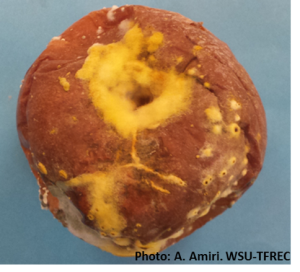Written by Achour Amiri, Assistant Professor of Plant Pathology
Yellow rot, previously described as Lambertella rot, has been identified very recently as a postharvest decay of apple. It is caused by a fungus named Lambertella corni-maris known to cause rots on some other crops. Very little is known about the prevalence and spread of this disease.
What does it look-like?
Decayed fruit exhibit spongy lesions with a strong white mycelium turning into yellow compact mycelium at full development (Figure 1). The fungus is a typical wound pathogen because it requires a wound in the fruit to penetrate the flesh and cause the decay. Therefore, as for many other decays, additional care is recommended at harvest to minimize fruit wounding.

Prevalence of yellow rot and cultivar susceptibility
In spring of 2016, we conducted a survey including 160 grower lots from 16 packinghouses in the state. The decay was widespread and found in eight of ten counties included in the study. Yellow rot was found in 40% of lots surveyed at frequencies ranging from 2 to 39% and was found on 11 different cultivars. In laboratory studies, the fungus was able to infect nine apple cultivars but Honey Crisp, Piñata, and Fuji seemed more susceptible whereas Red Delicious and Granny Smith were less susceptible.
Control of yellow rot
In laboratory studies conducted on detached fruit, yellow rot was highly controlled by Scholar and Penbotec whereas the preharvest fungicide Pristine provided only a moderate control. On the other hand, thiabendazole (TBZ) failed to control yellow rot on detached apple fruit.
Future studies will focus on understanding the potential sources of inoculum and the spread of the disease in addition to evaluating the efficacy of additional preharvest fungicides and the best timing of application to enhance yellow rot management.
Some of the pesticides discussed in this presentation were tested under an experimental use permit granted by WSDA. Application of a pesticide to a crop or site that is not on the label is a violation of pesticide law and may subject the applicator to civil penalties up to $7,500. In addition, such an application may also result in illegal residues that could subject the crop to seizure or embargo action by WSDA and/or the U.S. Food and Drug Administration. It is your responsibility to check the label before using the product to ensure lawful use and obtain all necessary permits in advance.
Contact
Dr. Achour Amiri
Tree Fruit Research and Extension Center
509-663-8181 ext 268

